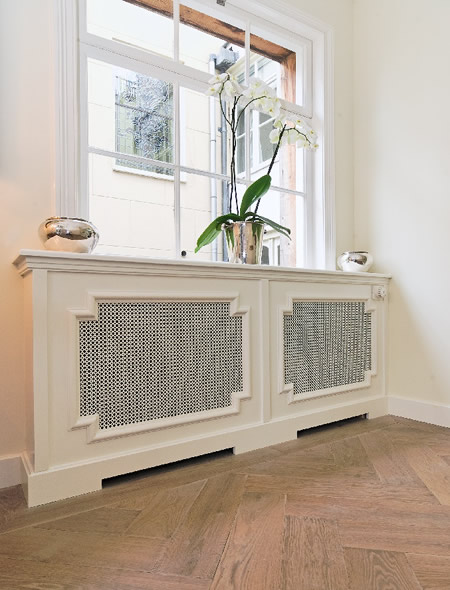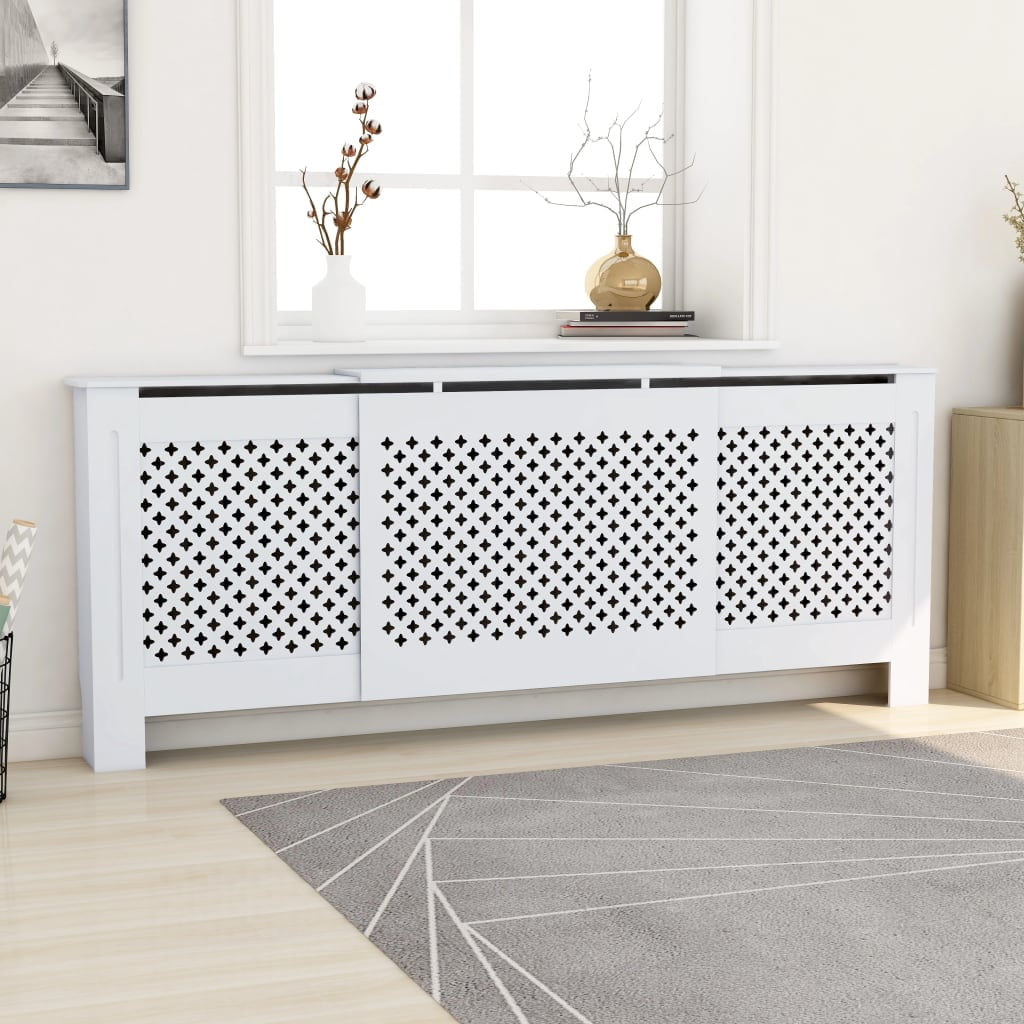The Smart Homeowner’s Guide to Installing Custom Radiator Covers
The Smart Homeowner’s Guide to Installing Custom Radiator Covers
Blog Article
Key Features to Consider When Choosing Customized Radiator Covers for Your Room
Choosing customized radiator covers entails a number of essential aspects. Product sturdiness is necessary for durability, while layout must harmonize with the existing decor. Dimension fit is vital for functionality and visual appeals. Furthermore, factors to consider around heat effectiveness and air movement can impact performance. Nonetheless, the subtleties of setup and maintenance frequently remain ignored. Understanding these elements will assist you towards an educated decision that improves your area easily. What other components should be taken right into account?

Material Options for Custom-made Radiator Covers
When choosing custom radiator covers, the choice of products plays a crucial function in both appearances and performance. Numerous materials are readily available, each with one-of-a-kind residential properties that satisfy different requirements. Wood, as an example, uses a classic look and can be quickly customized, however it might be susceptible to warping in high moisture. Metal alternatives, such as light weight aluminum or steel, offer durability and heat resistance, making them appropriate for high-heat environments. custom radiator covers.For those looking for a modern touch, MDF (medium-density fiberboard) is a popular selection; it can be repainted or ended up to match any kind of decor while remaining cost-effective. In addition, some may choose acrylic, which enables innovative designs and openness, although it may not be as heat-resistant. Inevitably, the selection of material greatly impacts not only the cover's appearance but additionally its long life and efficiency in properly handling warmth result
Style Designs to Suit Your Home Decoration
Radiator covers offer a practical function, their style can considerably boost the general aesthetic of a space. Property owners can select from various styles to seamlessly integrate these covers right into their existing design. For a contemporary appearance, smooth metal or minimal wood layouts offer a tidy, modern ambiance. In comparison, conventional homes might benefit from ornate wooden covers with detailed carvings that reflect classic craftsmanship.Farmhouse styles often incorporate rustic components, using reclaimed timber for a warm, inviting touch. For those that like an eclectic method, strong colors and patterns can be employed to produce a statement piece that draws the eye.Additionally, integrating open layouts or ornamental grilles can allow for air flow while including aesthetic passion. Selecting a design that complements the overall theme of the home assurances that the radiator cover ends up being not just a useful component but likewise an elegant prime focus within the space.
Size and Fit Factors To Consider
Just how can property owners guarantee their custom-made radiator covers fit perfectly within their rooms? Exact dimensions are necessary for accomplishing a smooth fit. Property owners ought to start by measuring the length, size, and elevation of their radiators, taking into account any kind of protruding elements such as pipes or shutoffs. In addition, it is vital to take into consideration the surrounding room, making sure that the cover does not obstruct air flow or hinder furnishings placement.Choosing the ideal material and style can also affect fit; for instance, some materials may need specific thicknesses to assure sturdiness. Homeowners ought to additionally consider the intended style of the space, making sure that the cover matches existing design while fitting pleasantly in the designated location. A well-measured and attentively designed cover not just improves aesthetic appeals but additionally ensures reliable heating by allowing appropriate ventilation around the radiator.
Installation Refine and Needs
To ensure a successful installation of custom radiator covers, cautious planning and focus to detail are essential. One must precisely gauge the radiator dimensions and bordering room to confirm an appropriate fit. Next off, choosing the best materials is necessary; alternatives might consist of timber, steel, or composite products, each calling for specific tools and methods for installation.Before starting the setup, it is a good idea to gather all essential tools, such as brackets, screwdrivers, and drills, to streamline the process. The installment area should be free from barriers for safety and efficiency.Once prepared, the custom covers can be securely placed, ensuring that they are leveled and straightened appropriately. Adhering to producer standards during this stage is critical to prevent any kind of architectural concerns. A thorough inspection ought to be carried out to verify that the covers are firmly attached and visually enticing, contributing to the total visual of the room.
Warmth Performance and Air Movement
When choosing customized radiator covers, warm performance and airflow are essential factors to contemplate. Correct ventilation style warranties perfect warm distribution throughout a space, preventing chilly spots and taking full advantage of comfort. Interest to these elements can greatly enhance the overall efficiency of a heating unit.
Optimum Heat Circulation
Ideal heat circulation is vital for maintaining a comfortable indoor setting, and custom radiator covers can considerably boost this procedure. custom radiator covers. These covers are developed not only for appearances but also to maximize warm performance. By directing cozy air successfully throughout the area, they stop cool spots and assure that warmth flows equally. Correctly created covers can assist in airflow while decreasing blockage, enabling warm air to rise and disperse naturally. Furthermore, the materials made use of in customized radiator covers can impact heat retention and outcome. Picking covers that balance style and capability is vital, as they can add considerably to a home's general home heating performance, enhancing convenience and possibly lowering power expenses in the future
Air Flow Style Factors To Consider
Reliable air flow layout is vital for making certain optimal warmth effectiveness and air movement precede with radiator covers. When choosing a personalized cover, it is vital to take into consideration functions that promote unhampered air movement. Grilles and vents must be tactically placed to allow cozy air to distribute openly while protecting against overheating. Furthermore, the material of the cover can influence air movement; light-weight products usually advertise much better ventilation contrasted to much heavier choices. The style needs to additionally represent maintaining useful source ideal distances between the cover and radiator to enhance efficiency. Inevitably, a well-designed radiator cover will certainly not only improve the aesthetic allure of a space yet additionally add to efficient home heating, creating a much more comfy atmosphere.
Personalization and Customization Attributes

Upkeep and Care Tips for Longevity
Preserving custom radiator covers is crucial for their durability and appearance. Routine dusting practices, using suitable cleaning services, and seasonal examinations can considerably boost their longevity. Executing these treatment suggestions ensures that the covers remain practical and aesthetically appealing gradually.
Routine Cleaning Practices
Consistently dusting custom-made radiator covers is essential for preserving their appearance and functionality. Dirt buildup can obstruct air flow, potentially affecting the radiator's performance. It is suggested to implement a regular cleaning routine, ideally once a week, to prevent build-up. A soft microfiber fabric or a duster is recommended for this job, as these materials efficiently catch dirt without damaging the surface. Care needs to be taken to clean the areas surrounding the radiator cover as well, ensuring that my site no dust is left to clear up. For homes with pet dogs or high foot web traffic, even more regular cleaning may be required. This straightforward maintenance practice not only enhances the visual charm however likewise adds to the durability of the radiator cover.
Suitable Cleaning Up Solutions
Choosing appropriate cleaning solutions is essential for the durability of custom radiator covers. Home owners ought to choose gentle, non-abrasive cleansers to avoid damages to the surface finish. Moderate soap blended with warm water is typically efficient for general cleansing, while preventing harsh chemicals that might strip the material. A soft cloth or sponge is suggested for application, making certain that no gritty materials are made use of that could damage the cover. It's crucial to dry the cover extensively after cleaning up to avoid dampness accumulation, which can bring about rust or mold and mildew. Normal upkeep with ideal cleansing items not only improves the appearance of the radiator covers however likewise expands their life expectancy, ensuring they stay a useful and visual component of the space.

Seasonal Examination Tips
Although customized radiator covers are developed for durability, conducting seasonal inspections is crucial for guaranteeing they remain click site in excellent problem. Property owners ought to start by looking for any indicators of damage, such as dents, scrapes, or rust. In addition, confirming that the cover fits snugly and firmly around the radiator is necessary, as loosened fittings can result in inadequacies. Throughout evaluations, dust and particles should be removed to avoid buildup that can block airflow. Inspecting for dampness or mold is important, as these can jeopardize the cover's stability. Examining the paint or coating for wear permits for prompt touch-ups, improving both aesthetics and durability. Regular inspections aid keep performance and appearance while extending the life-span of custom radiator covers.
Regularly Asked Questions
Can I Use Personalized Radiator Covers in Outdoor Spaces?
The concern of utilizing personalized radiator covers in outdoor areas arises frequently. Usually, these covers are developed for interior usage, as outside conditions can damage products and impact functionality, making them unsuitable for exterior atmospheres.
What Is the Ordinary Expense of Customized Radiator Covers?
The typical cost of custom radiator covers commonly varies from $200 to $800, relying on products, dimension, and style complexity. Homeowners must consider their budget plan and visual preferences when deciding.
Are There Eco-Friendly Material Options Available?
The inquiry relating to environment-friendly material options revealed that various lasting products, such as reclaimed wood, bamboo, and recycled metals, are offered for personalized radiator covers, attracting eco conscious customers seeking fashionable and responsible home services.
Just how Do I Clean Detailed Designs on Radiator Covers?
Cleaning intricate designs on radiator covers requires a gentle strategy. Soft fabrics or brushes with mild soap and water can effectively eliminate dirt and crud, making sure that the delicate information remain intact while maintaining the cover's appearance.
Do Customized Radiator Covers Minimize Noise From the Heater?
Custom radiator covers can assist lower noise from heating unit by dampening vibrations and noise. Their design often includes insulating materials, which additionally lessens sound transmission, developing a quieter and extra comfortable environment in the area. When selecting personalized radiator covers, the option of materials plays a necessary function in both appearances and capability. Additionally, the products used in personalized radiator covers can impact warm retention and result. Reliable ventilation layout is necessary for guaranteeing optimal warm effectiveness and air movement in rooms with radiator covers. Customized radiator covers are designed for sturdiness, carrying out seasonal evaluations is vital for ensuring they remain in ideal condition. The typical cost of custom radiator covers generally ranges from $200 to $800, depending on materials, size, and style complexity.
Report this page